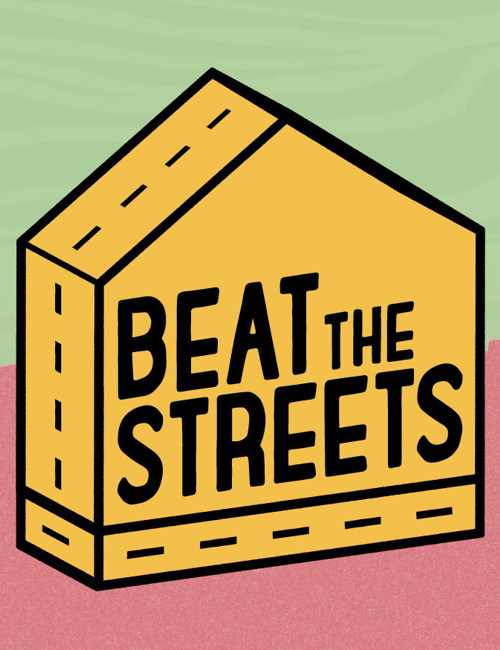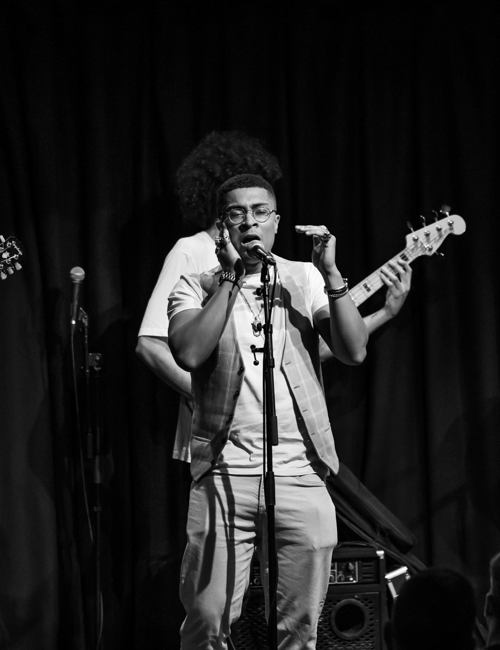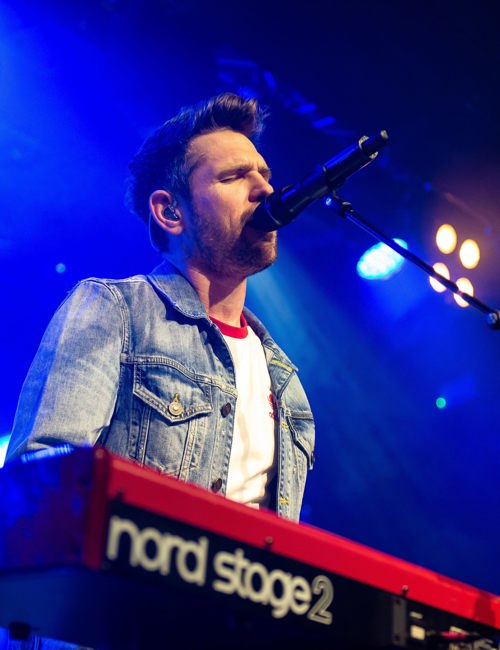
Our Ash. photo: Holly Booth
You began your working life as a writer while at university, how did that come about?
I was doing a journalism degree at Bournemouth, and I started doing my first interviews with Terrovision, Tripping Daisy, bands like that for the student magazine. Between the second and third year I did work experience at Melody Maker and Kerrang!, and off the back of that I started freelancing.
In my final year at university I was writing for Melody Maker, but because I was the new kid in the on the list, if they needed a review doing in Sheffield, I’d travel up there for a thirty quid gig review. Maybe even £20... I’d be like, “Guys, you know where I live, right?” It was cool still, it was when mobile phones had just become available and I had one of those brick-like ones, and occasionally it’d ring and I’d be like, “That’ll be Melody Maker…. ‘You want me to review Prolapse. OK. Yep.’”
When I graduated, I’d moved back to Derby and a job came up at Kerrang!. I had the interview, didn’t really know what I was talking about, but they brought me in as Reviews Editor. I ended up living in this bonkers place in Marble Arch. Who lives in Marble Arch? I tell you who, the UK’s over-fifty female weightlifting champion and she has a basement flat. That first six months was crazy, gig reviews every night... I'd been to London twice before that in my life.

SO Festival, Skegness. The Lift. photo: Ash Bird
I think that’s called a baptism of fire. It must have been good fun, though?
Yeah, my twenties were an adventure. I was Reviews Editor for a couple years and I realised that I’d missed a step. So I went freelance, travelled the world. When the Editor’s job came up, I thought I was too young for it, but I went for it because at that point I was running the Kerrang! club nights and we’d just done a big tour of the UK, which meant that I was meeting the readers.
I went into the interview saying, “I’ve done the market research, the readers come up and ask me questions and say what they want. I don’t think anybody’s got a better handle on the readers right now – the other people you're interviewing never leave the office.” They wanted to give something new a try, so…
You were 26 at the time – did you feel that the pressure was on because of your age?
Yeah. I was the youngest ever Editor of Kerrang! A lot of the staff were there when I came in as a 21- or 22-year-old not knowing what the hell I was doing. You get into it because you love music, and then you get an editorship and you’ve got to tell the staff there's a pay freeze, or have a disciplinary meeting with someone ten years older than you and tell them their attitude isn’t quite right. “Why is that my job, I just like rock music.”
My big thing was that I was there right when pop was becoming ‘rock’; Avril Lavigne, Busted, Franz Ferdinand and Maroon 5. I’m proud to say that I stood by not putting in Avril and Maroon 5… not on my watch. I think I was the last Kerrang! Editor to fiercely defend that, it then became more commercially minded. I remember that pressure, and the whole Kerrang! experience was hard work: Every Thursday night in the office till ten trying to put the thing to bed, and then Friday becomes about turning the next one around.
I did the best part three years as Editor, that’s about 150 issues. I was knackered at the end of it. I’d love to do something one day that I'm as proud of – I’m proud of the work I do, but I don't want three years in twenties to be my headline act.

Download Festival 2011. Bring Me The Horizon. photo: Ash Bird
Did you move straight into photography after leaving? Had it been a hobby before then?
No, I had a point and shoot. What had been a hobby in a sense was that most of the writing trips you go on are with a photographer. Part of writing a feature is almost always observing the shoot. The Kerrang! photographers were amazing, they turned stuff round so quickly. I was good friends with Paul Harries, and Scarlett Page, who is Jimmy Page’s daughter. It was fun going on feature trips and waiting for the band to realise who she was. When I left, I bought my first proper camera and spent a few years of teaching myself before I was happy to say that I could do it for money.
Did you learn quite a lot through watching them, then?
Watching them work was just amazing, sometimes being like their assistant and helping set up lights and stuff. I wish I knew what I know now about photography when I was commissioning it because now I look back and think about the negative feedback I might have given or the unrealistic commissions and think, “that must have been really irritating.”

SO Festival. The Wheel House. photo: Ash Bird
What did you do in the transitionary stage between being an editor and a photographer?
I moved to Brighton, and I wrote for Total Film and some local mags. It was really refreshing to talk to somebody about nothing to do with record contracts, or fans, or say “so do you guys like to party on tour?” “So there are brothers in your band – do you fight?” Seven years of those questions, you know…
One of the most interesting interviews I‘ve ever done was with a Church of England vicar called Peter Owen Jones who did a TV programme called Extreme Pilgrim where he would go and do ‘work experience’ with other types of religions. I’ve done Marilyn Manson, I’ve done Slipknot… but this vicar had just spent thirty days in a cave in the hills to try to see about getting closer to God because of this other religion. It was fascinating.
Do you miss the writing?
I never actually loved the writing, it was the interviewing and the experiences. I did a lot of stuff with At The Drive In – they were my band – starting with them when they just had their first UK gig, then going to New York with them, and then watching it blow up and blow up and then implode. Being part of that whole journey, to be on the inside and see it happen, it was amazing.
So it was more the observations, and the inspiration from people who were doing something great. The thing I want out of photography is the same thing I wanted out of journalism – it’s a way to meet interesting people. I love doing actors head shots because it’s a couple of hours of talking to an up-and-coming actor about how they see their career going, the films they love. I really like meeting people.
You did a lot of work for BIMM – British and Irish Modern Music institute – photographing the students. Did the sheer volume and time constraints of the work push your practice?
I’ve photographed about 180 of their students, and I tried to make every shoot different. I’d find ways to turn one venue into backdrops for all the different types of musicians. Looking around and thinking, “Right, there’s an industrial looking radiator and I’ve got a metal drummer coming later, so I’ll save that. There's a bit of a garden, that could be quite folky.”

BIMM Institute student Bethan Walton. photo: Ash Bird
It was a great way of learning how to adapt one place into four and then do three different setups within those four areas. By the end of it I was absolutely knackered, I might have tried to do too much. I also learned to take a little thing that turns into a homemade headshot background, so I always have a black or white background if everything's a nightmare.
You mention your portable studio kit on your website – is that quite a unique thing?
I'm really into my lighting – it’s become what defines my style. It wasn’t until I got into lighting that I start to love portraiture. It's like a magic trick, you can take a grimy corner, and with a bit of lighting it turns into a cinematic scene. That’s what excites me. I started off with four small hotshoe flashes, but when I was getting bigger work, I wanted something with a bit more power.
I use Elinchrom lights that are the smallest and lightest battery-powered proper flashes. I've still kept everything compact so I can take stuff on my own and set up a four-light photography studio in the corner of a pub in Manchester. I'm not the only person with this sort of kit, but I might be the only one without two assistants. I like the creative clients, the smaller businesses and artists that are just climbing up. My challenge is to do the photos that I want to do, at the highest quality, without pricing myself out for the people I want to do it for.

This is Empire. photo: Ash Bird
Do you find that you go through phases of what you prefer to shoot?
Not so much. Landscapes are where everyone starts because there isn't somebody standing there saying, “You don’t know what you’re doing with that camera, do you?” You can stand in a field trying to set up a camera for as long as I like and no one knows. I sort of fell into the live music stuff because when I first started as a photographer, all my contacts were from my Kerrang! days.
I blagged into some photo pits, but I was thinking “I’ve just got out of this business, do I still want to be in this business?” With the live music stuff, I’ve had recent experiences that were great: I somehow became the UK photographer for the Zac Brown Band. They’re huge in the States, they’ve had ten consecutive number ones on the American Country chart, Dave Grohl loves them and he produced their last EP, they're a huge deal. I had full access to the Wembley Arena stage that has three tiers, and them to say, “Go where you like: you can get on the drum riser, behind the keyboard, we’re used to that sort of thing.”
How do you go about choosing locations?
What I'm looking for when I'm looking for a place where I can do four shoots in a day, I need as many plain-ish surfaces as possible. The worst places are ones that where the walls are plastered with pictures in frames with reflective glass. I just want different colors and textures. But sometimes you do get like a photographic equivalent of the flashing cursors up for white page. I love location shoots but you don't know what the weather's going to do.

Unnamed Instrumental Project. photo: Ash Bird
There's one shoot I did where this band are playing chess in a lake. Everyone loves that shot and it’s funny because I wanted to cancel that shoot because an hour before it was cacking it down with rain. We got there, the clouds broke and the shoot was amazing. Carla [Mundy] was stood on the edge of the lake with this boom light, one of the band is holding a flash gun that was taped to the inside of lampshade so it looks like he's holding like a standard lamp – there’s quite a lot that could have gone wrong.
Do you have any particular shoots that stand out as favourites for you?
I did a shoot with You Slut!, a Nottingham band, and they wanted to be in gym whites doing cross country. I found on the internet this book cover with public schoolboys running through these muddy streams and I said, “I want to do this.” And they were like, “Yeah, fine.” It ended with them wanting to celebrate their run with milk and chicken.
The chicken never made it into a shot, but they’re there mucking around with with wine glasses of milk. We had this idea of having them throw milk in each other's faces, so we worked out who would be chucking milk at who. We didn’t have any more milk so it was a one-shot deal. The shot is brilliant because only one of them managed to actually hit another person. So it's three people throwing milk over their own shoulder and one person getting hit in the face. That shoot was hilarious from start to finish, but you don’t often get people quite as nuts as You Slut!

You Slut! photo: Ash Bird
Are you more into artificial lighting or do you use natural lighting too?
I'm not necessarily that proud to say it, but I love it. I’m a huge movie buff. I love to make a scene out of something simple. I want to make it perfect in my own head. Sometimes that’s a curse because you never can make it perfect, and for some people, the way I shoot would be too colourful, too glossy. I'm really colour based, I love the richness of it. I’m trying to make a picture that beautiful and that makes people go, “Oh, wow.” That’s a win for me. Whereas other photographers want to take a photograph of a poo in a lift because it shows degradation.
Are you pretty much self-taught?
Yeah, with the help of the Internet, and a couple of different photographers. I did a short lighting course and the most useful thing happened on the course was that someone else on the course mentioned a couple of books. If somebody's looking to get into light, there’s a book called The Hot Shoe Diaries by Joe McNally, he shoots for National Geographic and stuff like that.
He’s the master of small flash, and it's a book where he just talks about all these shoots and how he did them all with these small flashes, just cheap ones that you can get for £30. It's amazing. I books about lighting, and about art – people who defined how we light stuff. Caravaggio, his paintings, the whole light and shade thing, that’s how I light things. Back up a minute, I’m not claiming to be the Caravaggio of the Nottingham photography scene.

BIMM Institute student Freddie Hook. photo: Ash Bird
Have you always worked in digital?
Yeah. But saying that, I’m friends with Dan, who runs The Photo Parlour by the station, and I did buy myself a 1957 Rolleiflex medium format camera. You just look at these things and you go, “Why don't we make stuff this beautiful any more? That Rolleiflex, it’s over sixty years old. I wish you could do like a Who Do You Think You Are on your camera, that camera has been taking photographs since the fifties, what’s it been pointed at? I have no idea what that camera has seen.
Your course, Demystifying the DSLR, at Broadway – tell us a bit about that...
I used to teach for a national training company, but I had to teach exactly the way they'd written the course, which was frustrating. I've been trying to do my own version, to teach it my way. When Broadway opened up their new spaces downstairs, it was perfect for what I wanted and Tasha and Paul from Know How at Broadway backed me.
We had twelve people on the first one, proving that saying, “If you put it in the Broadway brochure, they will come.” The one we’re doing at the moment is the entry level: you’ve got a DSLR and you don’t know what to do with it off auto settings. When you first buy a DSLR, your first reaction is disappointment because you think you’re buying something that you’re going to point at something and it’s going to look amazing. Well, until you know how to drive it, it’s not going to look amazing.
It’s not until you learn how to use it, you don’t realise the potential of it. To go from auto mode to using modes where you’ve got control, it’s not that difficult. And by the end of the day you’re wondering why you haven’t been doing this all along. It’s extremely satisfying.
Will you be taking the course further?
I’m writing part two which will be Mastering the DSLR. I’ve got plans for other stuff too, I want to do something that’s less technical, because whether you take pictures on a phone, a DSLR or an analogue camera, you’re a photographer in a way. I want to do something that for people who love taking pictures on their phone. More compositional based, looking at light and using their cameras without it being super technical. I’ve got ideas for talks for teenagers who are thinking they might like to do a photography degree. So stuff that combines career advice with technical advice.
Demystifying the DSLR, Digital Photography Workshop, Broadway Cinema, Saturday 24 September, 10am, £75/£90
We have a favour to ask
LeftLion is Nottingham’s meeting point for information about what’s going on in our city, from the established organisations to the grassroots. We want to keep what we do free to all to access, but increasingly we are relying on revenue from our readers to continue. Can you spare a few quid each month to support us?




